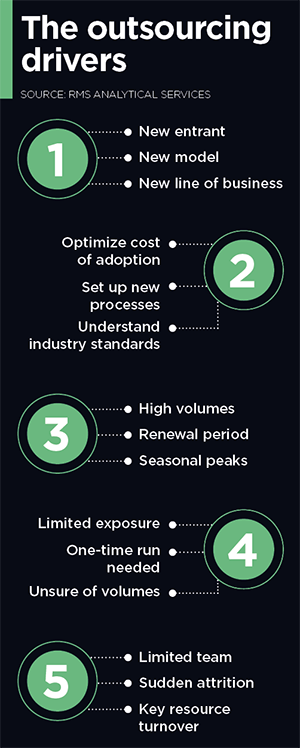EXPOSURE explores the rationale, challenges and benefits of adopting an outsourced model function
Business process outsourcing has become a mainstay of the operational structure of many organizations. In recent years, reflecting new technologies and changing market dynamics, the outsourced function has evolved significantly to fit seamlessly within existing infrastructure.
On the modeling front, the exponential increase in data coupled with the drive to reduce expense ratios while enhancing performance levels is making the outsourced model proposition an increasingly attractive one.
The Business Rationale
The rationale for outsourcing modeling activities spans multiple possible origin points, according to Neetika Kapoor Sehdev, senior manager at RMS.
“Drivers for adopting an outsourced modeling strategy vary significantly depending on the company itself and their specific ambitions. It may be a new startup that has no internal modeling capabilities, with outsourcing providing access to every component of the model function from day one.”
There is also the flexibility that such access provides, as Piyush Zutshi, director of RMS Analytical Services points out.
“That creates a huge value-add in terms of our catastrophe response capabilities — knowing that we are able to report our latest position has made a big difference on this front”
Judith Woo
Starstone
“In those initial years, companies often require the flexibility of an outsourced modeling capability, as there is a degree of uncertainty at that stage regarding potential growth rates and the possibility that they may change track and consider alternative lines of business or territories should other areas not prove as profitable as predicted.”
Another big outsourcing driver is the potential to free up valuable internal expertise, as Sehdev explains.
“Often, the daily churn of data processing consumes a huge amount of internal analytical resources,” she says, “and limits the opportunities for these highly skilled experts to devote sufficient time to analyzing the data output and supporting the decision-making process.”
This all-too-common data stumbling block for many companies is one that not only affects their ability to capitalize fully on their data, but also to retain key analytical staff.
“Companies hire highly skilled analysts to boost their data performance,” Zutshi says, “but most of their working day is taken up by data crunching. That makes it extremely challenging to retain that caliber of staff as they are massively overqualified for the role and also have limited potential for career growth.”
Other reasons for outsourcing include new model testing. It provides organizations with a sandbox testing environment to assess the potential benefits and impact of a new model on their underwriting processes and portfolio management capabilities before committing to the license fee.
The flexibility of outsourced model capabilities can also prove critical during renewal periods. These seasonal activity peaks can be factored into contracts to ensure that organizations are able to cope with the spike in data analysis required as they reanalyze portfolios, renew contracts, add new business and write off old business.
“At RMS Analytical Services,” Zutshi explains, “we prepare for data surge points well in advance. We work with clients to understand the potential size of the analytical spike, and then we add a factor of 20 to 30 percent to that to ensure that we have the data processing power on hand should that surge prove greater than expected.”
Things to Consider

Integrating an outsourced function into existing modeling processes can prove a demanding undertaking, particularly in the early stages where companies will be required to commit time and resources to the knowledge transfer required to ensure a seamless integration. The structure of the existing infrastructure will, of course, be a major influencing factor in the ease of transition.
“There are those companies that over the years have invested heavily in their in-house capabilities and developed their own systems that are very tightly bound within their processes,” Sehdev points out, “which can mean decoupling certain aspects is more challenging. For those operations that run much leaner infrastructures, it can often be more straightforward to decouple particular components of the processing.”
RMS Analytical Services has, however, addressed this issue and now works increasingly within the systems of such clients, rather than operating as an external function. “We have the ability to work remotely, which means our teams operate fully within their existing framework. This removes the need to decouple any parts of the data chain, and we can fit seamlessly into their processes.”
This also helps address any potential data transfer issues companies may have, particularly given increasingly stringent information management legislation and guidelines.
There are a number of factors that will influence the extent to which a company will outsource its modeling function. Unsurprisingly, smaller organizations and startup operations are more likely to take the fully outsourced option, while larger companies tend to use it as a means of augmenting internal teams — particularly around data engineering.
RMS Analytical Services operate various different engagement models. Managed services are based on annual contracts governed by volume for data engineering and risk analytics. On-demand services are available for one-off risk analytics projects, renewals support, bespoke analysis such as event response, and new IP adoption. “Modeler down the hall” is a third option that provides ad hoc work, while the firm also offers consulting services around areas such as process optimization, model assessment and transition support.
Making the Transition Work
Starstone Insurance, a global specialty insurer providing a diversified range of property, casualty and specialty insurance to customers worldwide, has been operating an outsourced modeling function for two and a half years.
“My predecessor was responsible for introducing the outsourced component of our modeling operations,” explains Judith Woo, head of exposure management at Starstone. “It was very much a cost-driven decision as outsourcing can provide a very cost-effective model.”
The company operates a hybrid model, with the outsourced team working on most of the pre- and post-bind data processing, while its internal modeling team focuses on the complex specialty risks that fall within its underwriting remit.
“The volume of business has increased over the years as has the quality of data we receive,” she explains. “The amount of information we receive from our brokers has grown significantly. A lot of the data processing involved can be automated and that allows us to transfer much of this work to RMS Analytical Services.”
On a day-to-day basis, the process is straightforward, with the Starstone team uploading the data to be processed via the RMS data portal. The facility also acts as a messaging function with the two teams communicating directly. “In fact,” Woo points out, “there are email conversations that take place directly between our underwriters and the RMS Analytical Service team that do not always require our modeling division’s input.”
However, reaching this level of integration and trust has required a strong commitment from Starstone to making the relationship work.
“You are starting to work with a third-party operation that does not understand your business or its data processes. You must invest time and energy to go through the various systems and processes in detail,” she adds, “and that can take months depending on the complexity of the business.
“You are essentially building an extension of your team, and you have to commit to making that integration work. You can’t simply bring them in, give them a particular problem and expect them to solve it without there being the necessary knowledge transfer and sharing of information.”
Her internal modeling team of six has access to an outsourced team of 26, she explains, which greatly enhances the firm’s data-handling capabilities.
“With such a team, you can import fresh data into the modeling process on a much more frequent basis, for example. That creates a huge value-add in terms of our catastrophe response capabilities —
knowing that we are able to report our latest position has made a big difference on this front.”
Creating a Partnership
As with any working partnership, the initial phases are critical as they set the tone for the ongoing relationship.
“We have well-defined due diligence and transition methodologies,” Zutshi states. “During the initial phase, we work to understand and evaluate their processes. We then create a detailed transition methodology, in which we define specific data templates, establish monthly volume loads, lean periods and surge points, and put in place communication and reporting protocols.”
At the end, both parties have a full documented data dictionary with business rules governing how data will be managed, coupled with the option to choose from a repository of 1,000+ validation rules for data engineering. This is reviewed on a regular basis to ensure all processes remain aligned with the practices and direction of the organization.
“Often, the daily churn of data processing consumes a huge amount of internal analytical resources and limits the opportunities to devote sufficient time to analyzing the data output” — Neetika Kapoor Sehdev, RMS
Service level agreements (SLAs) also form also form a central tenet of the relationship plus stringent data compliance procedures.
“Robust data security and storage is critical,” says Woo. “We have comprehensive NDAs [non-disclosure agreements] in place that are GDPR compliant to ensure that the integrity of our data is maintained throughout. We also have stringent SLAs in place to guarantee data processing turnaround times. Although, you need to agree on a reasonable time period reflecting the data complexity and also when it is delivered.”
According to Sehdev, most SLAs that the analytical team operates require a 24-hour data turnaround rising to 48-72 hours for more complex data requirements, but clients are able to set priorities as needed.
“However, there is no point delivering on turnaround times,” she adds, “if the quality of the data supplied is not fit for purpose. That’s why we apply a number of data quality assurance processes, which means that our first-time accuracy level is over 98 percent.”
The Value-Add
Most clients of RMS Analytical Services have outsourced modeling functions to the division for over seven years, with a number having worked with the team since it launched in 2004. The decision to incorporate their services is not taken lightly given the nature of the information involved and the level of confidence required in their capabilities.
“The majority of our large clients bring us on board initially in a data-engineering capacity,” explains Sehdev. “It’s the building of trust and confidence in our ability, however, that helps them move to the next tranche of services.”
The team has worked to strengthen and mature these relationships, which has enabled them to increase both the size and scope of the engagements they undertake.
“With a number of clients, our role has expanded to encompass account modeling, portfolio roll-up and related consulting services,” says Zutshi. “Central to this maturing process is that we are interacting with them daily and have a dedicated team that acts as the primary touch point. We’re also working directly with the underwriters, which helps boost comfort and confidence levels.
“For an outsourced model function to become an integral part of the client’s team,” he concludes, “it must be a close, coordinated effort between the parties. That’s what helps us evolve from a standard vendor relationship to a trusted partner.”







